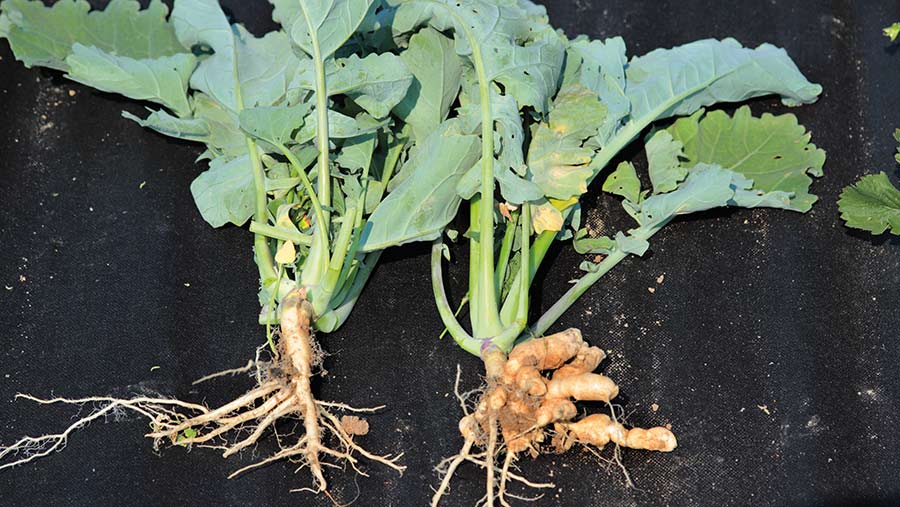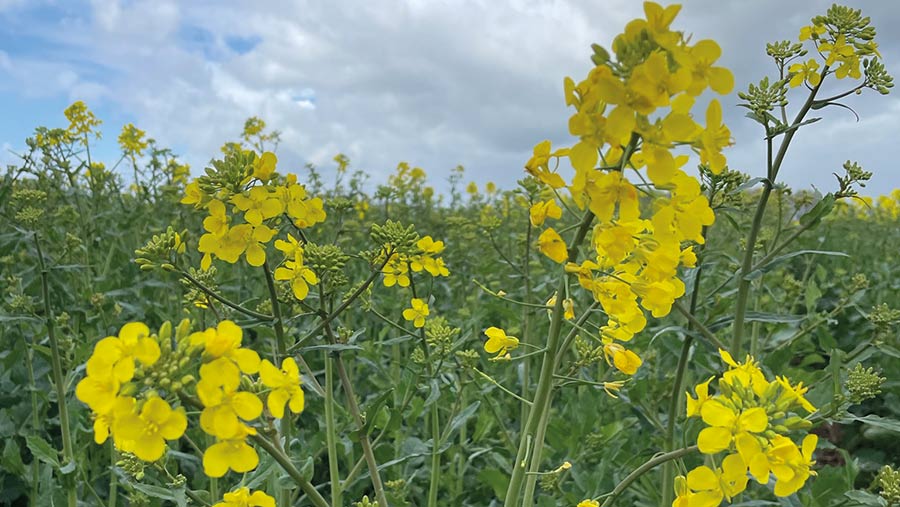How OSR growers will benefit from two new disease genes
New resistance genes for clubroot and phoma will offer growers better varietal control of these two costly diseases in oilseed rape crops.
Both are welcome additions as existing genes have become less effective in recent years, with increasing reports of disease overcoming the plant’s defences.
See also: How technology lets crops turn pollution into fertiliser
For clubroot, all the specialist varieties rely on the same gene and the disease is being seen in some of these.
And with phoma, there are suggestions that there is too much reliance on the RML7 gene, which has become less effective.
Here, Farmers Weekly looks at how OSR growers will benefit from the two new genes as varieties enter UK National List trials.
Clubroot
A new clubroot resistance gene offers farmers greater varietal control of the disease, which is becoming a more widespread problem in the UK.
Changing weather patterns, tight rotations and the increasing popularity of cover crops are all thought to be behind the increasing incidence of clubroot (see panel).
The disease is even being seen in known resistant varieties, overcoming varietal resistance. This leaves growers with limited options, as all the current varieties rely on the same Mendel gene.

Club root © Aleksa/Adobe Stock
That is until now, as DSV is set to introduce a new gene called CRE1, which stands for Clubroot Resistance Enhanced 1.
Alex Doering, the company’s UK managing director, explains that it is a novel trait that was introduced by crossing with the distant relative Brassica rapa.
However, as with the current resistance gene, it is only partial with resistance to specific races, so it doesn’t protect against all races in the soil.
Six races have been identified, of which P1, P2 and P3 are the most important.
In the UK, the Mendel gene offers resistance in more than 80% of cases, says Dr Doering.
In the fields where it doesn’t work, investigations often reveal a history of turnip growing that has led to a change in the races present.
The good news is that the new gene is resistant to more strains, and infection experiments in the greenhouse with various isolates demonstrate enhanced resistance over the existing Mendel gene.
He believes this takes it up to resistance in 90% of cases.
An integrated approach
Even with enhanced resistance, the advice for growers will remain unchanged – they should not rely solely on varietal resistance and other measures should also be deployed.
That’s because growing these varieties will select for races that overcome resistance.
The measures include:
- Crop rotation: aim for one in five years or longer for oilseed rape
- Destroy cruciferous weeds and oilseed rape volunteers. Ideally, do this early before spores build up
- Do not drill too early – the move to earlier drilling to beat cabbage stem flea beetle has increased risk
- Grow a variety with resistance
- Increase soil pH by liming
- Prevent standing water – good drainage helps cut the risk. The disease likes moisture and may be first seen in patches next to woodland
- Prevent spread of the disease via infested soil by cleaning machinery between fields.
The first variety, is expected to be registered in the EU this coming winter and is for UK National List application in 2023 at the earliest.
Why is clubroot getting worse?
Clubroot is such a difficult disease to manage because its spores can rest in soil for many years.
In the presence of susceptible plant roots, these resting spores germinate and infect the root hairs, causing the characteristic distortion.
Alex Doering says spores have a half life of 3.6 years. Combined with its unbelievably high replication rate, even after 30 years, you can still have infection.
Within one generation, which takes less than six weeks in optimal conditions, the spores can multiply 100,000-fold.
These spores are exceptionally hard wearing and can even survive a cow’s digestive tract. Once established, clubroot is very difficult to eradicate or even stop from spreading.
He believes the reason farmers are seeing more of the disease is because of tight rotations, along with the increasing popularity of cover crops, which often contain brassicas.
There are also many weed hosts, such as hedge mustard and shepherds purse, “so it’s impossible to have a field without any host plants for clubroot”.
For this reason, Dr Doering advises against having any brassicas in cover crops where there is OSR is in the rotation.
Brassica weeds and crops show virulence on the most aggressive clubroot strains, he says.
Oil radish cultivars should also not be used as they could promote the strains that may overcome resistant varieties.
Phoma
Oilseed rape growers are set to benefit from varieties with enhanced resistance against phoma, containing a brand new gene.
Current varieties rely on a single gene, the most popular being RML7 resistance. This gene has been on the market since 2010 and an over-reliance on it has seen its effectiveness fall in recent years.
DSV international OSR product manager Simon Kroeger estimates that about 70% of the current UK OSR area relies on the RLM7 gene.
Consequently, the disease is overcoming it and you are starting to see stem canker despite having this gene, and scores are getting weaker, he warns.
Mr Kroeger points to trials in Denmark where phoma varieties without any qualitative resistance showed an average score of 7.5, with a range of 6.5 to 8.5.
This is on a score of 0-10, with 0 being excellent resistance with no phoma spotting in evidence and 10 being highly susceptible.
Varieties with the RLM7 resistance had a wider range of phoma susceptibility scores from 4-9, but of real concern is that the average was the same at 7.5
The good news for growers is that a new gene, LepR1, from DSV offers much greater resistance.
While LepR1 by itself has shown to have the best resistance to the most common strains in fields across Europe, DSV believes it is most effective when used in conjunction with other resistance traits.
Therefore, the breeder says all future varieties with the new gene will also have the RML7 resistance.
This combination offers protection against all the strains seen in Europe and will be marketed as Combination Phoma Blocker.
In the same Danish trial, varieties with Combination Phoma Blocker had an average score of just 2.3. He says the first variety will be available for UK growers to drill in summer 2024.

Phoma blocker in trial © MAG/Richard Allison
Mode of action
“LepR1 is already being used in Australia and Canada, so we know how the resistance works,” he says.
The plant responds to infection with a ring of callose and lignin around the infection, stopping any spread at the early stages. This wall/barrier is a different mechanism to other genes.
Mr Kroeger believes this new resistance will be especially helpful in min-till and direct drill situations, as research shows it can significantly reduce the level of spores released to the soil.
Decreasing resting spores will be valuable. Ideally, debris should be buried. Decreasing resting spores will help where crop debris remains on top of the soil.
Spores mature and are released to potentially infect new leaves if given the right conditions.

